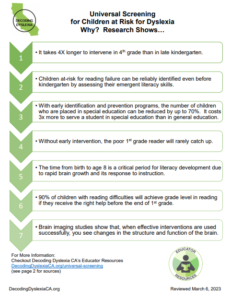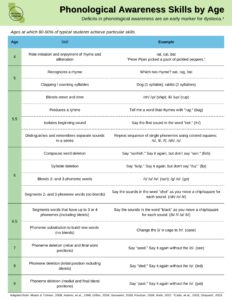
Universal Screening for Reading Difficulties
Importance of Early Identification
Infographic
The Incremental Cost of Waiting
In California, 72% of fourth graders are not reading at grade level (Nation’s Report Card, 2015). These bleak statistics remain the same for students in the eighth grade. Despite the hard work of many talented teachers, the state of California is one of the lowest performing states in the nation in reading. Extensive evidence exists that struggling readers who do not receive early, evidence-based intervention will continue to fall behind their peers. One of the most compelling findings from reading research is that children who get off to a poor start in reading rarely catch up (Stanovich, 1986). The consequences of a slow start in reading become monumental as they accumulate exponentially over time. Stanovich (1986) refers to this as the “Matthew effect” (the idea that, in reading, the rich get richer and the poor get poorer due to differentiated exposure to text) associated with failure to acquire early word reading skills and the the consequences can range from:
- negative attitudes toward reading
- reduced opportunities for vocabulary growth
- less practice in reading than other children receive
- less likely to complete high school
It is imperative that school districts and teacher preparation programs provide professional development for K-12 teachers to raise awareness about dyslexia and how best to teach students with dyslexia.
Warning
Universal screening is useless unless it results in interventions that target the deficit with evidence-based instruction by highly-trained educators.
Research has shown it takes 4 times longer to intervene in 4th grade as it does in late kindergarten because of brain development and because of the increase in content for students to learn as they grow older (International Dyslexia Association, 2017; Lyon, 2001).
Many school districts do not identify struggling readers until the third grade (or later). This makes successful remediation more difficult and more costly. Teachers can help by asking site and district administrators for:
- training on Structured Literacy™ approaches to teaching reading and spelling
- universal screening in grades K-3
- budgets to support intervention/reading specialists in schools
- time to collaborate about student reading outcomes and share best practices on core reading lessons and reading interventions, ideally within a comprehensive and collaborative RtI/MTSS model.
The Long Term Social and Emotional Consequences of Illiteracy Are Even More Dire and May Include:
- anxiety, depression, and other social, emotional, and mental health conditions on the order of two to five times greater than those of their peers (California Dyslexia Guidelines, 2017, Wilson, et al., 2009)
- feelings of low self-worth, frustration, despair and self-defeating coping mechanisms (California Dyslexia Guidelines, 2017)

This repeated failure in school may lead to low academic self-concept and low self-esteem, which in turn may lead to behavior problems that are secondary but equally important to the learning issues. Those with low self-esteem tend to respond less to intervention (California Dyslexia Guidelines, 2017; Nelson, et al., 2003).
The Importance of Early Universal Screening
Universal screening allows a school to focus on the students who show early warning signs for becoming “at risk” readers. Included in this group of “at risk” readers will be children with reading disabilities, such as dyslexia, as well as children who will struggle to read for other reasons. Children at risk for reading failure can even be reliably identified before kindergarten.
Thanks to advances in neuroscience, we know that younger children have greater brain plasticity and this plasticity decreases through childhood. This means that there is a very narrow window of time where interventions can have the greatest impact making the time from birth to age 8 a critical period for literacy development (Nevills & Wolfe, 2009).
Universal screening allows schools to provide targeted focus to “at risk” groups at a time that will create the greatest impact on improving future outcomes. This upfront investment in early identification and evidence-based intervention will save schools money by decreasing the amount required to be invested in providing costly special education services, due process proceedings (including settlement agreements) and expensive nonpublic school placements.
Warning Signs for Students “At Risk” for Reading
The warning signs for students “at risk” for reading failure will change over time as student’s language and reading skills develop.
The important role that phonemic awareness and rapid automatized naming (RAN) play in the development of future reading skills cannot be emphasized enough. These two areas must be integrated into any universal screening students in kindergarten through second grade. Other early indicators would include letter-sound identification and letter naming fluency.
It is critical that both the classroom and intervention educators have a strong grasp of phonological and phonemic awareness and its developmental timeline — from early phonological awareness tasks to more advanced phonemic awareness tasks. This will be covered in detail in the “Teaching Tools” educator module (currently in development).
Infographic
Phonological Awareness Skills by Age
Given the increased family risk of dyslexia (occurring in up to 50% of individuals who have a first-degree relative with dyslexia (Grigorenko, 2004)), a family history of reading difficulties should be a factor given significant consideration in universal screening.
Particular attention should be paid to children who are late to talk or who show delays in oral language development (especially accompanied by a family history of dyslexia or speech language impairment ) as they are at heightened risk for reading disabilities (Moll, et al., 2013; Catts, et al., 2017). In addition, attention should be paid to children who have had significant ear infections that impeded their ability to discern individual phonemes during the critical language development period of 6-18 months (Shapiro, et al., 2009; Kindig & Richards, 2000).
As Students Begin to Read, Additional Skill Areas Should Be Screened for Potential Deficits Such As:
- word recognition skills (real word reading),
- decoding skills/word attack (including nonsense word reading),
- oral reading fluency,
- measures of oral expression versus written expression,
- listening comprehension,
- reading comprehension, and
- spelling (encoding).
The importance of analyzing spelling errors cannot be stressed enough. Spelling errors provide indications of reading impairments since spelling is a reciprocal ability to decoding.
Video
A helpful video for teachers on analyzing handwriting samples.
There are Several Good Sources of Warning Signs and Assessment Domains by Grade Level that Should Be Used for Reference:
The New Jersey Department of Education has developed a helpful checklist in its NJ Dyslexia Handbook.
The International Dyslexia Association article on “Universal Screening: K-2 Reading” lists key domains by grade level that are indicators of future reading performance.
National Center on Response to Intervention Screening Brief Series article entitled “Brief #3: Predicting Students at Risk for Reading and Mathematics Difficulties” lists areas to be assessed by grade level.
The California Department of Education in its CA Dyslexia Guidelines has a chapter on “Characteristics of Dyslexia by Age Group—Strengths and Weaknesses” and a table on “Essential Components of Reading, Writing, and Spoken Language for Screening and Comprehensive Assessment”.
Sources
California Dyslexia Guidelines (2017, October). Ch. 5: Socioemotional Factors of Dyslexia. California Department of Education, 24-25.
Catts, H. W., McIlraith, A., Bridges, M., & Nielsen, D. (2017). Viewing a
Phonological Deficit Within a Multifactorial Model of Dyslexia. Reading and Writing: An Interdisciplinary Journal, 30, 613–629.
Gaab, N. (2017, February). It’s a Myth That Young Children Cannot Be Screened for Dyslexia! Baltimore, MD: International Dyslexia Association.
Grigorenko, E. L. (2004). Genetic Bases of Developmental Dyslexia: A Capsule Review of Heritability Estimates. Enfance, 56(3), 273–288. doi:10.3917/enf.563.0273.
International Dyslexia Association (2017). Just the Facts: Oral Language Impairments and Dyslexia. Baltimore, MD: IDA.
International Dyslexia Association (2017). Universal Screening: K–2 Reading. Baltimore, MD: IDA.
Kindig, J.S., & Richards, H.C. (2000). Otitis Media: Precursor of Delayed Reading. Journal of Pediatric Psychology, 25(1), 15-18.
Lyon, G.R., & Fletcher, J. (2001, Summer). Early Warning System. Education Matters 2001, 23–29.)
Moll, K., Loff, A., & Snowling, M. J. (2013). Cognitive Endophenotypes of Dyslexia. Scientific Studies of Reading, 17, 385–397.
National Center on Response to Intervention (2013, January). Screening Briefs Series—Brief #3: Predicting Students at Risk for Reading and Mathematics Difficulties. Washington, DC: U.S. Department of Education, Office of Special Education Programs, National Center on Response to Intervention.
Nelson, J. R., G. J. Benner, and J. Gonzalez. 2003. Learner Characteristics That Influence the Treatment Effectiveness of Early Literacy Interventions: A MetaAnalytic Review. Learning Disabilities Research and Practice 18 (4): 255–67.
Nevills, P., & Wolfe, P. (2009). Building the Reading Brain, Pre K-3 (2nd ed.). Thousand Oaks, CA: Corwin Press.
Shapiro, L.R., Hurry, J., Masterson, J., Wydell, T.N., & Doctor, E. (2009). Classroom Implications of Recent Research into Literacy Development: from Predictors to Assessment. Dyslexia, 15(1), 1-22.
Stanovich, K.E. (1986). Matthew Effects in Reading: Some Consequences of Individual Differences in the Acquisition of Literacy. Reading Research Quarterly, 21, 360-406.
Torgesen, J. K. (1998). Catch Them Before They Fall. American Educator, 22, 32-41.
Torgesen, J. K. (1998). Catch Them Before They Fall: Identification and Assessment to Prevent Reading Failure in Young Children. Reading Rockets (Note: This is the same article as above but in a more user-friendly format.).
U.S. Department of Education, Institute of Education Sciences, National Center for Education Statistics, National Assessment of Educational Progress (NAEP). Nation’s Report Card: 2015 Reading Snapshot Report, California, Grade 4, Public Schools.
Wilson, A. M., C. D. Armstrong, A. Furrie, and E. Walcot. 2009. The Mental Health of Canadians with Self-Reported Learning Disabilities. Journal of Learning Disabilities 42 (1): 24–40.


